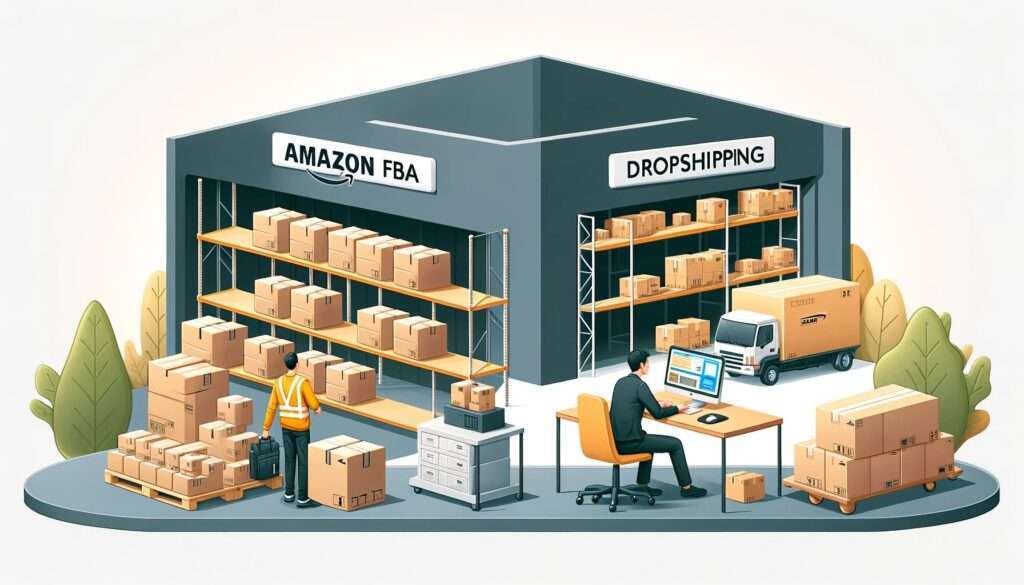
Choosing Amazon FBA vs dropshipping can be challenging. This decision affects your e-commerce business’s success. Amazon FBA vs dropshipping offers distinct advantages and drawbacks. Each model impacts fulfillment, inventory, and profit margins. Amazon FBA allows sellers to use Amazon’s fulfillment centers, ensuring fast prime shipping.
However, FBA fees can be high. On the other hand, the dropshipping business model lets you sell products without holding inventory. This model may result in lower profit margins. To understand which is the better option for 2024, a detailed comparison is needed. This guide covers the pros and cons of each model.
How Amazon FBA and Dropshipping Works?
Amazon FBA handles inventory and order fulfillment for sellers. Products are stored in Amazon warehouses and shipped directly to customers. Sellers use Amazon’s platform for customer service and returns, reducing their workload.
Dropshipping involves a supplier who ships products directly to customers. Sellers list items on their ecommerce store without holding inventory. When an order is placed, the supplier ships the product to the customer, allowing sellers to focus on marketing and sales.
Amazon FBA vs Dropshipping: Which One’s Better?
Amazon FBA offers several advantages, including access to Amazon’s vast customer base and streamlined fulfillment processes. The need for inventory storage can increase costs, but Prime eligibility enhances customer trust and sales potential.
Dropshipping, on the other hand, requires a lower initial investment since sellers don’t need to purchase inventory upfront. The dropshipping model allows for flexibility but can result in lower profit margins and longer shipping times. Shopify is a popular platform for setting up a dropshipping business due to its user-friendly interface.
Choosing between Amazon FBA and dropshipping depends on your business model and goals. Amazon FBA suits those who prefer streamlined fulfillment and access to a large customer base, while dropshipping offers lower upfront costs and greater flexibility.
Amazon FBA vs Dropshipping: Pros and Cons
Amazon FBA
| Pros | Cons |
| Prime shipping eligibility increases sales potential | High fees for storage and fulfillment services |
| Amazon handles customer service and returns | Inventory storage requires upfront investment |
| Access to Amazon’s vast customer base | Strict guidelines and potential account suspension |
| Faster shipping times due to Amazon fulfillment centers | Limited control over the shipping process |
| Amazon provides tools for advertising and promotions | Monthly storage fees can add up |
Dropshipping
| Pros | Cons |
| Low initial investment with no inventory required | Lower profit margins compared to other business models |
| Flexible location as no physical inventory is needed | Longer shipping times can affect customer satisfaction |
| Wide range of products to offer from various suppliers | Higher competition due to ease of entry |
| Easy to start using platforms like Shopify | Reliance on suppliers for product quality and shipping |
| Ability to quickly test new products | Customer service must be handled personally |
Difference Between Amazon FBA and Dropshipping
| Aspect | Amazon FBA | Dropshipping |
| Inventory Management | Products sent to Amazon fulfillment centers | No inventory; products shipped directly from suppliers |
| Shipping | Amazon handles storage, shipping, and customer service | Suppliers ship products directly to customers |
| Startup Costs | Higher due to inventory purchase and storage fees | Lower with minimal initial investment required |
| Profit Margins | Generally higher due to controlled pricing | Lower due to competition and reliance on suppliers |
| Control | Limited control over the fulfillment process | More control over product selection and pricing |
| Shipping Time | Faster due to Amazon’s logistics network | Often longer depending on supplier’s location |
| Customer Service | Managed by Amazon | Handled by the business owner |
| Flexibility | Less flexible due to inventory requirements | More flexible with no inventory constraints |
| Competition | Moderate due to Amazon’s platform guidelines | High due to ease of entry and numerous sellers |
| Risk | Higher due to upfront inventory investment | Lower as there’s no need to purchase inventory upfront |
E-commerce Platforms and Integrations
Numerous e-commerce platforms and integrations are available for those choosing between Amazon FBA and dropshipping. Shopify is a popular choice, allowing seamless integration with various dropshipping services. For those selling products on Amazon, using the FBA program simplifies fulfillment. Amazon handles inventory storage and shipping, making it easier for FBA sellers.
BigCommerce and WooCommerce also offer robust solutions for dropshipping businesses. These platforms support integrations with major suppliers and streamline the dropshipping process. Sellers can easily manage their Shopify store or BigCommerce site while utilizing Amazon FBA for fulfillment. If you are looking to invest in online business, these e-commerce platforms provide a solid foundation to start and grow your venture.
E-commerce business models like dropshipping and FBA benefit from tools like Oberlo, ShipStation, and Inventory Source. These integrations help manage orders and track inventory effectively. Utilizing these platforms and integrations ensures a smoother fulfillment process and enhances overall business efficiency.
Conclusion
Deciding between Amazon FBA vs dropshipping depends on your business goals. Each model offers unique benefits and challenges. Amazon FBA provides robust fulfillment services, while dropshipping offers lower upfront costs. Which model do you think suits your business needs in 2024? Share your thoughts in the comments!



